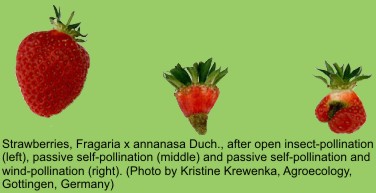
an extensive review of scientific studies from 200 countries and for 115 of the leading global crops. The study was co-authored by conservation biologist Claire Kremen, an assistant professor at the University of California Berkeley's Department of Environmental Science, Policy, and Management.
"There's a widely stated phrase in agriculture that you can thank a pollinator for one out of three bites of food you eat," said Kremen, who is also a member of the Committee on Status of Pollinators that produced the NRC report and leader of a group at the National Center for Ecological and Analysis and Synthesis that co-sponsored the work. "However, it wasn't clear where that calculation came from, so we set out to do a more thorough and reproducible estimate, and we wanted to look at the impact on a global scale."
What the researchers found fell in line with the dictum which Kremen cited. Out of the 115 crops studied, 87 depend to some degree upon animal pollination, accounting for one-third of crop production globally. Of those crops, 13 are entirely reliant upon animal pollinators, 30 are greatly dependent and 27 are moderately dependent.
Honey bees in North America have been decimated by infestations of parasitic mites, and are battling antibiotic-resistant pathogens and competition from Africanized honey bees. Kremen added that honey bees, particularly wild ones, are negatively impacted by habitat loss and a variety of non-sustainable farming practices. These impacts also affect native species of wild bees. There are 4,000 species of native bees in North America alone.
Kremen recently co-authored another study showing that wild bees interacting with honey bees can lead to a five-fold increase in pollination efficiency. "The problem is, if we don't protect the wild pollinators, we don't have a backup plan."
Kremen suggested developing a more sustainable form of agriculture. Some changes may involve mere tweaks to current practices, such as allowing weeds and native plants to grow and prosper along the border of the primary crop. Such non-crop plants, which are currently killed off by herbicides, can sustain a variety of wild bee species when the primary crops are not in bloom. Another change could be to switch from flood irrigation, which drowns bee species that nest in the ground, to spray irrigation when feasible.
The study in the Proceedings of the Royal Society B highlights what is at stake if steps to improve pollinator biodiversity are not taken. Lead author Klein cites an example: “Passion fruits in Brazil are hand-pollinated through expensive day-laborers as the natural pollinators, carpenter bees, are hardly available because of high insecticide use in the agricultural fields and the destruction of the natural habitats."
